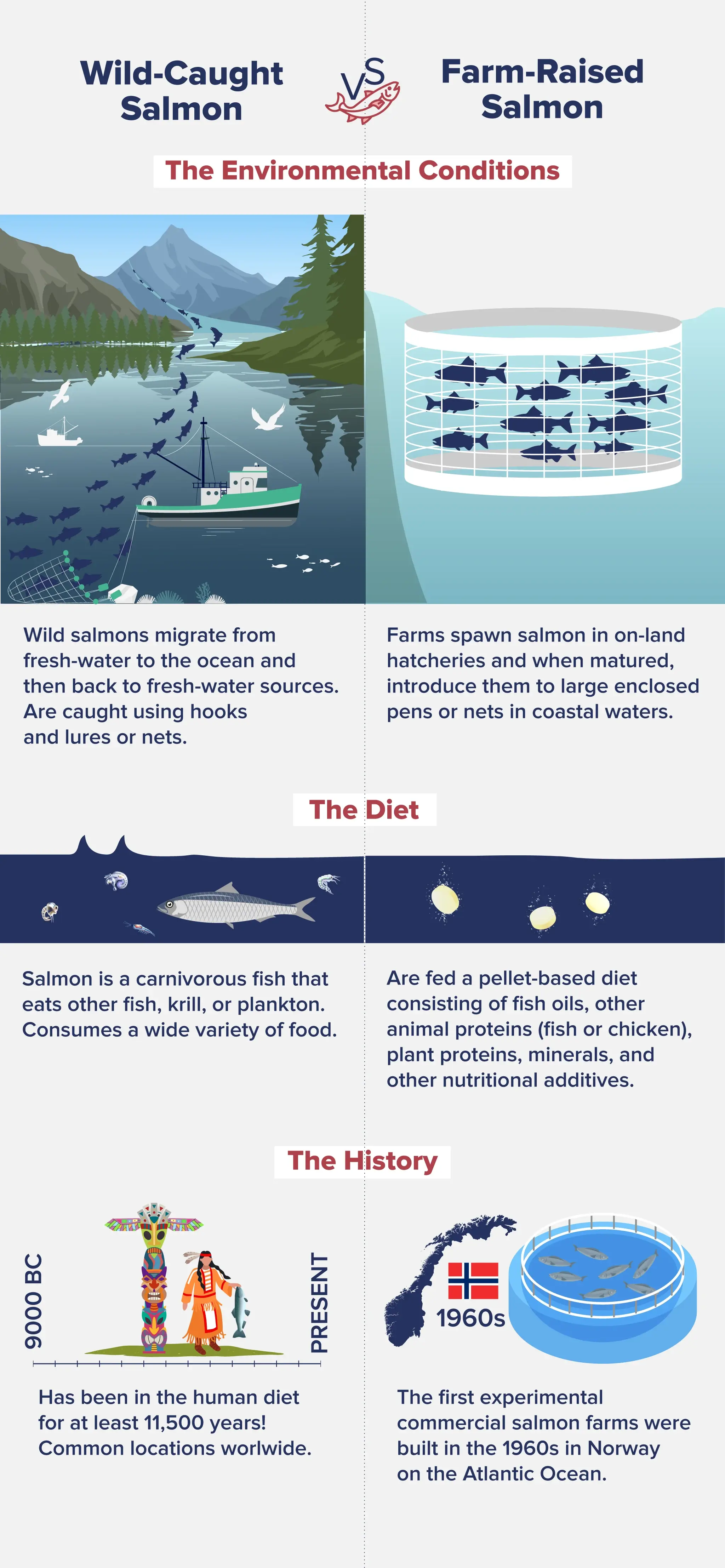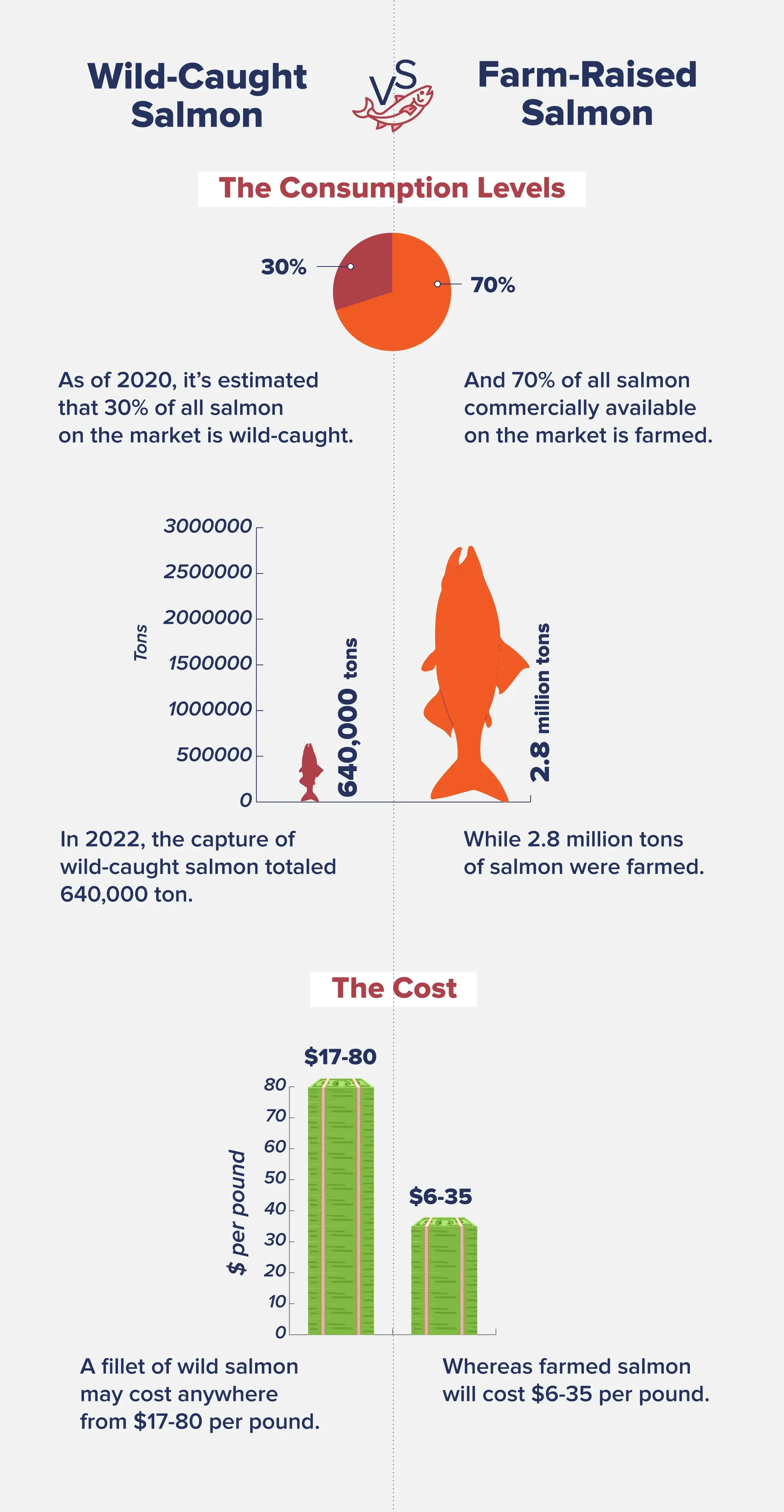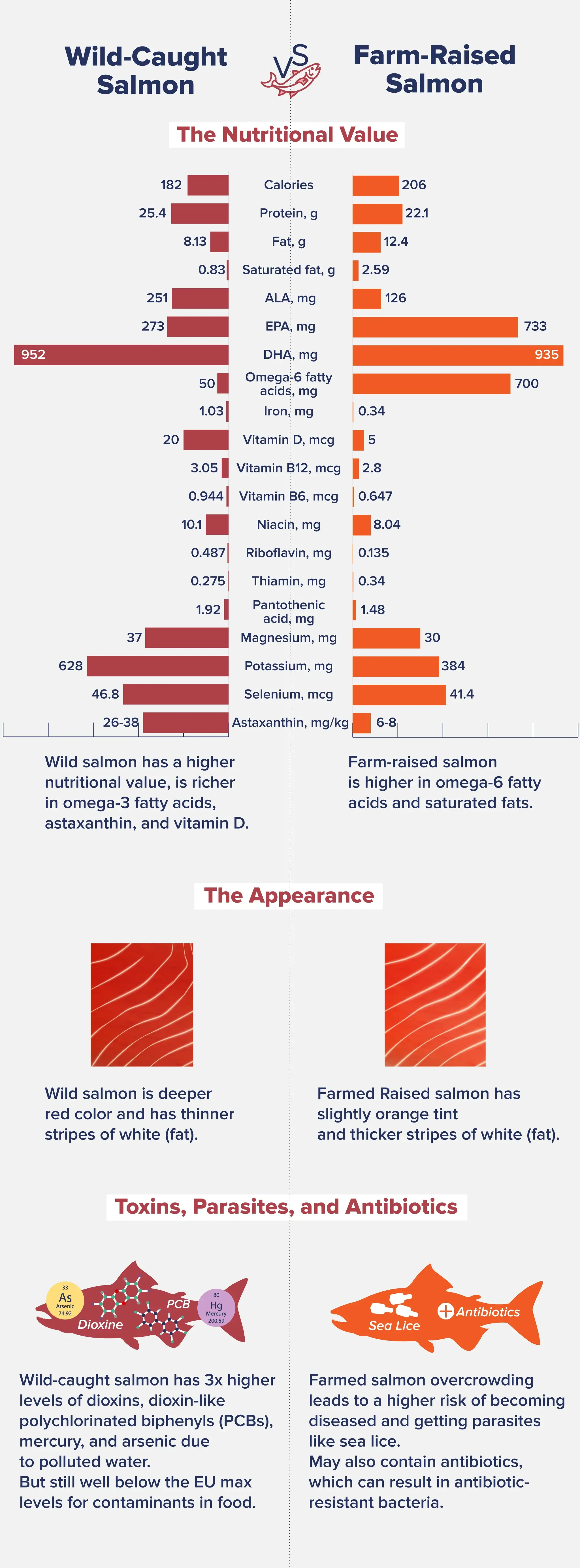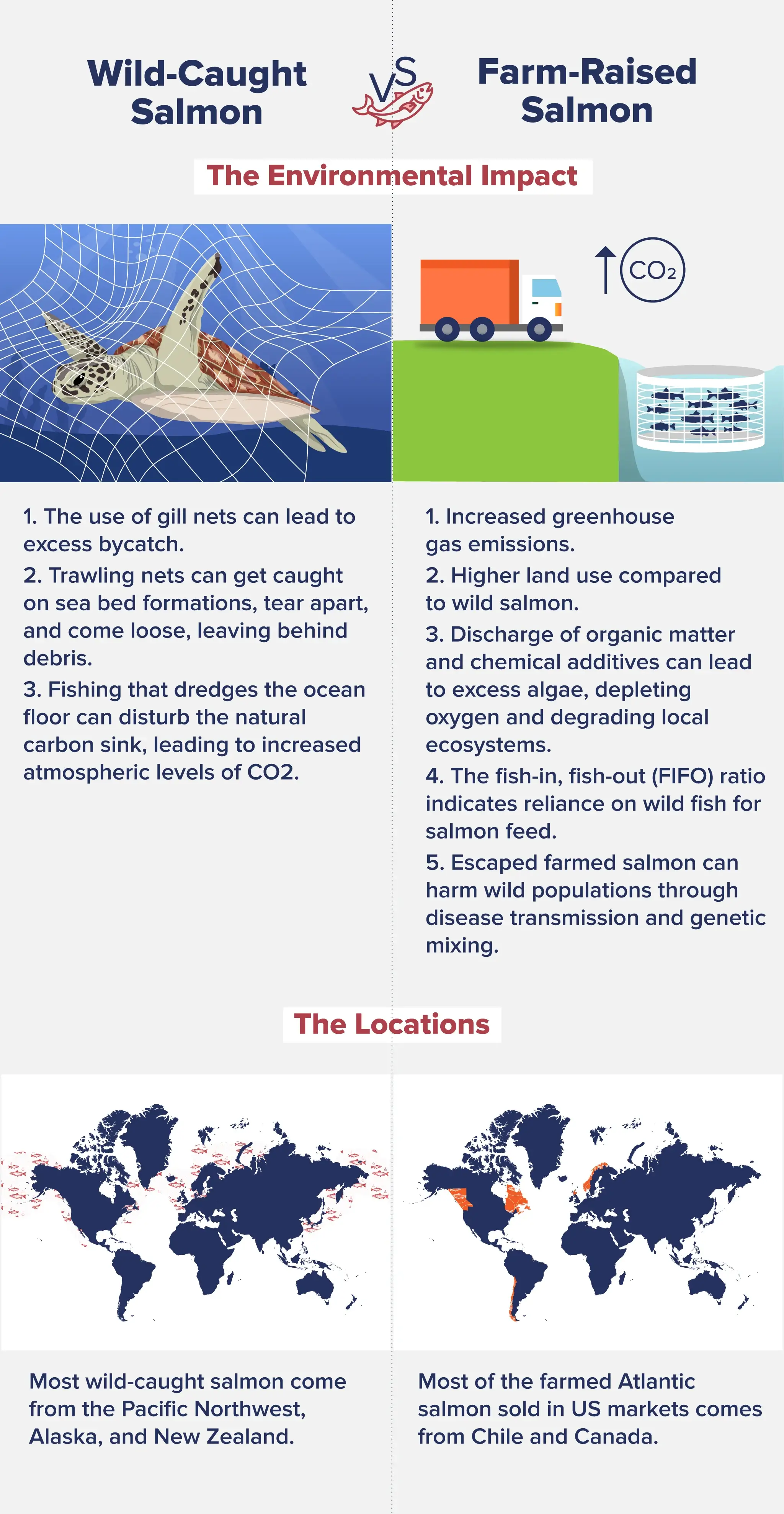Save $40 on your initial consult with a TNI Dietitian!
Talk to a real Dietitian for only $99: Schedule Now
This post contains links through which we may earn a small commission should you make a purchase from a brand. This in no way affects our ability to objectively critique the products and brands we review.
Evidence Based Research To fulfill our commitment to bringing our audience accurate and insightful content, our expert writers and medical reviewers rely on carefully curated research.
Read Our Editorial Policy
Consumers are becoming increasingly aware of our global food system’s impact on the environment, farmer livelihoods, and our health.
As a result, more people are asking questions and raising concerns about the source of their food and the quality and methods used to produce it—particularly our protein sources.
While cows, pigs, and chickens have (rightfully) hogged the limelight for decades, seafood is now taking center stage as the next industry to come under scrutiny for improved regulations.
That’s why, in this article, we’re talking about salmon, the second most popular seafood in the United States, behind shrimp.
When it comes to salmon production, there are two primary areas of concern: overfishing of wild-caught salmon and aquaculture practices used to farm salmon.
But which is better for the environment and for our health? As usual, when it comes to the world of food and agriculture, the answer is not as straightforward as we would hope.
With this in mind, this article will, at the very least, clarify the current state of these two industries, giving you the insight you need to wield your purchasing power as an informed consumer.
Salmon has been an integral part of the human diet for thousands of years (at least 11,500 to be exact) in locations around the world, from the Pacific Northwest to the British Isles, Japan, and Scandinavia.1,2
In fact, salmon even has cultural and religious importance to indigenous communities on the North American continent.3
However, the salmon our ancestors were eating millennia ago is not what we’ll find in the grocery store today.
As our population has grown, so too has the demand for salmon. Naturally, with eight billion people on the planet, the wild supply of salmon cannot keep up.
So we had two options:
A) Fish salmon into extinction (which we nearly did); or
B) Start cultivating salmon
There is also the “hidden” C option to regulate salmon fishing and reduce consumption. While we have done the former now that salmon aquaculture is thriving, the reduction of salmon consumption never seemed to be in the cards.
So, to sate our ever-expanding appetite for this delicious pink-fleshed fish, the first experimental commercial salmon farms were built in the 1960s in Norway on the Atlantic Ocean.4
And, thus, the divide in the characteristics of wild-caught salmon and farm-raised salmon was born and has only continued to widen since.
How much wider? In 2022, the capture of wild-caught salmon totaled 640,000 tons, while 2.8 million tons of salmon were farmed.

Since wild Atlantic salmon are listed as an endangered species, the majority of wild-caught salmon originate from the Pacific Ocean.
In the grocery store, you’ll find wild-caught salmon primarily come from around the Pacific Northwest, Alaska, and New Zealand.
Pacific salmon consists of the following species:5
Wild-caught salmon are typically harvested as they are migrating from the ocean back to fresh-water sources and are caught using hooks and lures or nets.
Typically, wild-caught salmon are about 2-3 times more expensive than farmed salmon, which (as we’ve learned) are harvested in much greater abundance. So, a fillet of wild salmon may cost anywhere from $17-80 per pound, whereas farmed salmon will cost $6-35 per pound.6
However, wild-caught salmon may have a leg up (or a fin up?) on farm-raised as it pertains to its nutrients and quality.
As of 2020, it’s estimated that 70% of all salmon commercially available on the market is farmed.7
Typically, farms are built in locations where salmon once existed or currently exist naturally, such as Norway (home of Mowi, the largest producer of farmed salmon), Scotland, Canada, and the USA’s Pacific Northwest and Alaskan regions.8
But that hasn’t stopped other countries without native salmon populations from breaking into the industry, such as Chile, Argentina (Faroe Islands), and Australia.
Most of the farmed Atlantic salmon sold in US markets comes from Chile and Canada.
The methods used to cultivate salmon are fairly straightforward. Farms usually spawn salmon in on-land hatcheries and then, once matured, will introduce them to large enclosed pens or nets located in coastal waters.
Once the salmon reach maturity, they are culled and may be processed in a nearby facility or sent overseas to be processed, packaged, and then distributed globally.
Since salmon are a carnivorous fish that typically eat other fish, krill, or plankton, they are typically fed a pellet-based diet consisting of fish oils, other animal proteins (fish or chicken), plant proteins, minerals, and other nutritional additives.9
However, since their diet is not what they would normally eat, farmed fish may lack the characteristic pinkish-red color of wild-caught salmon without supplementation.
To mimic the nutrients found naturally in their diet and make the salmon more appealing to consumers, farmed salmon are fed astaxanthin. This is a naturally occurring antioxidant compound (technically a carotenoid) that deposits a bright shade of pink in the salmon’s flesh.
If you’re reading this, you probably already know or have heard murmurings of the negatives of salmon farming. This ranges from the excess parasites and toxins found in farmed salmon as well as the lack of nutritional quality in comparison to wild salmon.
There is also, of course, the environmental impact of salmon farms, but we’ll get into all of that and more in the next few sections.

Besides the taste, one of the best reasons to eat salmon is its high levels of several nutrients we would benefit from eating more of.
To summarize, both farmed and wild salmon contain 50% or more of your daily serving of:
One of the biggest nutritional benefits of salmon besides the protein content is its high levels of omega-3 fatty acids, in particular EPA and DHA, which primarily come from cold-water fish like salmon, tuna, herring, and sardines.
Salmon also contains some of the ALA type of omega-3, but this is more common in the Western diet in products like plant oils, nuts, and some grass-fed animals.
We can convert ALA to EPA and DHA within our bodies, but the process is quite limited, so consuming external sources of EPA and DHA is beneficial, making salmon a great protein option to eat one or two times a week.
As mentioned previously, farmed salmon are fed a diet enriched with astaxanthin, but this compound is also found naturally in wild salmon.
Astaxanthin is a type of carotenoid that is a powerful antioxidant that may have the potential to prevent diabetes, cardiovascular diseases, and neurodegenerative disorders, and may also boost the immune system.10
Additionally, astaxanthin may work together with omega-3s like EPA and DHA to benefit the brain by reducing neurodegeneration and improving memory, sight, and mood.
Since salmon contains such high levels of omega-3s and astaxanthin, this is a potential brain superfood!
Salmon contains several types of B vitamins in high amounts, including B6, B12, niacin, riboflavin, pantothenic acid, and thiamine.
Each of these B vitamins has specific benefits for our body, ranging from energy metabolism and DNA repair to healthy blood cell formation and brain and nervous system regulation.
Salmon contains at least 20% or more of your daily value of each of these vitamins and over 100% of vitamin B12.
Humans primarily get their daily dose of vitamin D from the sun, but as humans have begun to spend more time indoors—working, eating, sleeping, etc.—the less vitamin D we get naturally.
But never fear; salmon is here to save you from a vitamin D deficiency!
Farmed salmon contains around 66% of your daily needs for vitamin D, while this study indicates wild-caught salmon can contain somewhere between 70 and over 100%.
To get more vitamin D from the sun, you can intentionally spend more time outdoors by sitting in direct sunlight for at least 5 to 30 minutes a day without SPF and with at least 25% of your body’s skin exposed.11
Where you fall on this time scale depends on how light or dark your skin is—lighter skin needs less time in the sun while darker skin needs more—and the time of day, as dawn and dusk produce fewer UV rays compared to afternoon hours.
However, let’s say you have a darker complexion, and you live in a place that doesn’t get lots of sunlight. Instead of getting your vitamin D by sitting in a risky tanning bed, you could just eat salmon.
If you’ve been patiently reading (or, be honest, scrolling) in search of this section, welcome! You’ve arrived.
To answer your question, though, there are two key aspects I want to explore: the health benefits and the sustainability of wild and farmed salmon.
Even if you don’t care that much about the environmental aspects, these two are interrelated and ultimately affect one another.
To answer this question, let’s first break down the average nutritional value of farmed versus wild salmon since there are several key differences between the two.
| In 100g cooked (Source: USDA) | Farmed Salmon12 | Wild Salmon13 | ||
| Total | DV% | Total | DV% | |
| Calories | 206 | 182 | ||
| Protein | 22.1g | 25.4g | ||
| Fat | 12.4g | 15.9% | 8.13g | 10% |
| Saturated fat | 2.59g | 13% | 0.83g | 4% |
| Omega-3 Fatty Acids | ||||
| ALA** | 126mg | 9% | 251mg | 18% |
| EPA*** | 733mg | 273mg | ||
| DHA*** | 935mg | 952mg | ||
| Omega-6 Fatty Acids*† | 700mg | 50mg | ||
| Iron | 0.34mg | 2% | 1.03mg | 6% |
| Vitamin D | 5mcg | 20% | 20mcg | 100% |
| Vitamin B12 | 2.8mcg | 117% | 3.05mcg | 127% |
| Vitamin B6 | 0.647mg | 38% | 0.944mg | 55% |
| Niacin | 8.04mg | 50% | 10.1mg | 63% |
| Riboflavin | 0.135mg | 10% | 0.487mg | 37% |
| Thiamin | 0.34mg | 28% | 0.275mg | 23% |
| Pantothenic acid | 1.48mg | 30% | 1.92mg | 38% |
| Magnesium | 30mg | 7% | 37mg | 9% |
| Potassium | 384mg | 8% | 628mg | 13% |
| Selenium | 41.4mcg | 75% | 46.8mcg | 85% |
| Astaxanthin | 6-8mg/kg | 26-38mg/kg | ||
*Approximate
**avg. 1,350mg for adults14
***no recommended dv%
†https://www.ncbi.nlm.nih.gov/pmc/articles/PMC7766777/15
If you quickly scan this chart, you’ll see that, in general, you will get greater nutritional value from eating salmon that are wild-caught.

There are a few reasons for the differences in nutritional value between wild and farmed salmon, but it mainly comes down to the farmed salmon’s feed.
Though aquaculturists do their best to replicate the nutrients a salmon would naturally eat in the wild, it’s not yet a perfect science.
Normally, farmed salmon would be fed a diet of fish oil and fishmeal (made from small fatty fish). However, the demand for farmed salmon has increased, placing pressure on the supply of marine sources for salmon feed that farms simply can’t keep up with.
As a result, fish farmers resort to terrestrial sources to substitute these nutrients, which may not be sufficient or as high of quality as marine sources.
You can see this reflected in the fat content of farmed salmon fillets. They are higher in fat than wild salmon, yet do not contain as much omega-3’s and instead are higher in omega-6 fatty acids.15
While omega-6’s are not bad in moderation, too much can lead to cardiovascular issues, diabetes, and even some forms of cancer.16
You can also see one of the other big differences is the vitamin D content.
Wild salmon get most of their vitamin D from the consumption of crustaceans (such as shrimp) and other fish, whereas farmed salmon rely entirely on the vitamin D available in their feed.
These two nutrients are just two examples of how wild salmon is of better nutritional quality than farmed salmon.
More concerning than differences in the nutritional content between wild and farmed salmon is wild salmon’s much higher levels of harmful chemicals and toxins due to polluted water.
In a small study that sampled the fillets of 20 farmed, 17 escaped, and 23 wild Atlantic salmon, the research found that wild salmon had three times the concentrations of dioxins, dioxin-like polychlorinated biphenyls (PCBs), mercury, and arsenic compared to farmed salmon.15
While this might sound alarming, the levels found in the wild fish were still well below the EU maximum levels for contaminants in food.
Regardless of the regulations, I’m sure most consumers would prefer to eat food that does not have any of these compounds.
The reason for this is likely due to environmental contaminants. Farmed salmon escape exposure to the brunt of these toxins since much of their feed has transitioned away from marine sources.
Finally, the last concern with farmed salmon pertains to their health, which subsequently affects ours.
Farmed salmon are kept in pens in the open ocean to prevent them from escaping, keep them somewhat in their natural environment, and also reduce the overwhelming overhead costs that raising salmon on land would incur.
With this style of aquaculture, many hundreds of salmon are kept in each pen, which can lead to overcrowding. The effects are not too dissimilar to hens raised in cages or large enclosed barns.
In conditions where farmed salmon are packed together in close quarters, they are at a higher risk of becoming diseased and getting parasites like sea lice.
This can lead to a menagerie of unsightly deformities, stress, premature death, and potentially pain and suffering.
To counteract this, farmers use antibiotics, which can lead to a host of other issues—the least of which is consuming remnants of those antibiotics.
The real concern is transmitting antibiotic-resistant bacteria to you and wild salmon or other fish populations if they escape.
One of the primary reasons we as a global community have turned to farm-raising fish is to meet the demands of an ever-growing mass of consumers.
After hunting wild Atlantic salmon in the northeastern US into extinction and nearly doing the same to all Atlantic salmon, it became clear that a solution was needed if we were to continue our current levels of consumption.
However, this was not done with the primary intention of protecting global marine biodiversity or the populations of salmon that did survive the wave of overfishing in the mid-to-late 20th century and early 21st century.
What few environmental and ecological benefits farm-raised fisheries have provided wild salmon are simply a byproduct. Since the first experimental farm was raised in Norway, the potential of farm-raised fisheries represented an economic opportunity, not an environmental one.
Consequently, aquaculture has exploded in the last sixty years and is the agroindustrial activity with the highest growth rate worldwide. Today, this industry is valued at over 85 billion dollars.17
For better or worse, this has provided the leverage different organizations and legislative bodies needed to protect at-risk species in the wild.
Now, farmed fish are a bit of a pandora’s box, and they aren’t going anywhere. Even as we realize that they may be less sustainable and ultimately not as healthy as wild fish stock, proposed solutions must also have “economic feasibility.”17
But, to be fair to both sides, I will address the sustainability challenges of both farmed and wild salmon.
The way fishing vessels catch salmon depends on the species. For chinook and coho species of salmon, fishers can use baited hooks and lures, which are arguably much less impactful than other fishing methods.
However, since pink and sockeye salmon primarily eat small krill and plankton (meaning they won’t go for bait on a hook), commercial fishing vessels may use gillnets or trawlers—large cone-shaped nets that are dragged along the bottom of the ocean floor.
The use of gill nets can lead to excess bycatch—the unintended capture of other aquatic species. This method can severely impact populations of species that are already at risk, such as sea turtles. These animals can become distressed and die while struggling in the nets, leaving us no chance to return them to the ocean.
Trawling nets can cause further ecological problems for sea life and the environment. For one, these nets can get caught on sea bed formations, tear apart, and come loose, leaving behind debris that may take centuries to decompose or harm sea life that gets caught in it.
More disturbing, however, is that commercial fishing that dredges the ocean floor can lead to a disturbance of the natural carbon sink formed by dying plankton. When disturbed, this can increase atmospheric levels of CO2, further exacerbating global warming.18

There are simply hundreds of articles and research papers published about the numerous environmental effects of farm-raised salmon. I’ll try my best to summarize the primary concerns below.19
Nowadays, there are lots of regulations in place to protect at-risk populations of salmon, especially in the Pacific Northwest.
However, in many places where there are no protections for wild salmon, there can be an acute ecological impact if too many wild salmon are removed from their natural habitat.
This is because salmon are considered a keystone species, meaning that a sudden collapse in their population can have a ripple effect on other species in the environment.21 This includes orcas, bears, and smaller species and microbes that consume them after they die from the breeding process.22
With this in mind, there is an argument to be made that farm-raised salmon can place less pressure on wild stocks of salmon and protect salmon populations from overfishing.
Nutritionally, wild-caught salmon are superior to farm-raised salmon since they are in their natural environment until they are harvested. This makes them healthier throughout their entire lifecycle, and they consume a wider variety of food, making them not only tastier but also more nutritionally dense.
Even if wild-caught salmon is more expensive per pound, this may make it the better choice if you are seeking the healthiest option for yourself or your family.
On the other hand, there are several considerations regarding the sustainability of wild-caught salmon.
The management of wild fisheries to prevent overfishing that could impact both local and wider interconnected ecosystems is vital.
Yet, legislators can be slow to react. With the time required to create legislation and regulations—and establish the proper processes to enforce these regulations—commercial fishing operations may have an irreversible impact on ecosystems and the environment at large.
For those who care about their health yet also feel an ethical or moral obligation to eat sustainably, what’s the answer then?
Well, you can reduce your intake of salmon and (or) search for a brand of salmon that only makes their catch from sustainable sources.
If you want to know exactly which types of salmon from specific locations are certified sustainable, head to Seafood Watch’s Sustainable Salmon Guide.23
Seafood Watch not only recommends certain species and locations of wild-caught salmon you can purchase but also sustainable sources of farm-raised salmon if you need a more budget-friendly option.
In terms of nutritional content, wild-caught salmon generally contains higher levels of protein, omega-3 fatty acids, and vitamin D while also being lower in calories and overall fat content. They also tend to live healthier lives until they are harvested, whereas farmed salmon can suffer from diseases and parasites.
Farmed salmon may taste different from wild-caught salmon due to various factors, including diet, environment, and processing methods. Farm-raised salmon are typically fed a controlled diet of fish, terrestrial animal, and plant proteins and may include supplements like astaxanthin to enhance their color. As a result, farm-raised salmon may be fattier and more mild in flavor. Wild-caught salmon, which feed on a diverse range of natural foods, tend to have a stronger flavor. So, some people may prefer the taste and consistency of farmed salmon, while others may prefer the more distinctive flavor of wild-caught salmon.
Despite its widespread availability and lower cost compared to wild-caught salmon, farmed salmon has a much more intense environmental impact. Farmed salmon are also often fed a diet that may include antibiotics, synthetic pigments, and other additives to promote growth and coloration, which can raise food safety and health concerns. Additionally, the crowded conditions in salmon farms can lead to stress, disease, and welfare issues for the fish.
While salmon is a nutritious food rich in protein, omega-3 fatty acids, and essential vitamins and minerals, it’s generally not recommended to eat it every day due to potential risks of mercury and other contaminants. Like other types of seafood, salmon may contain trace amounts of mercury, PCBs, and other environmental pollutants, especially in larger, older fish. To minimize these risks, balance your diet with a variety of nutrient-rich foods from different food groups.